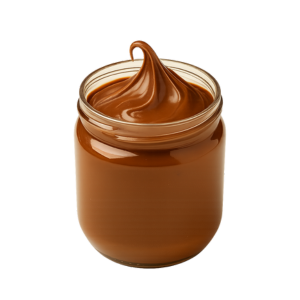
Nutella
Caffeine
5–6 mg
Note: Caffeine amounts are based on the cocoa content in Nutella. Actual levels may vary slightly depending on batch and serving size. Larger portions (such as multiple tablespoons or a full jar) increase caffeine proportionally.
| Attribute | Value |
|---|---|
| Caffeine Level | Low |
| Serving Size | 2 Tbsp |
| Serving Size (g) | 37 g |
| Caffeine | 5–6 mg |
| Calories | 200 kcal |
| Sugar | 21 g |
| Caffeine per fl oz | 2–3 mg/fl oz |
Nutella is a beloved hazelnut cocoa spread enjoyed worldwide. While most people think of it as a sweet treat, some wonder about its caffeine content, since cocoa naturally contains caffeine.
What Is Nutella and Why Does It Contain Caffeine?
Nutella is made from a blend of hazelnuts, sugar, palm oil, skim milk, and cocoa powder. The cocoa is the reason Nutella contains caffeine, though in very small amounts compared to coffee or tea.
Key traits of Nutella include:
- Main Ingredients – Sugar, palm oil, hazelnuts, skim milk, cocoa, soy lecithin, vanillin.
- Cocoa Content – Provides both flavor and trace caffeine.
- Texture & Flavor – Smooth, creamy, and sweet with a chocolate‑nutty taste.
- Global Popularity – Sold in over 160 countries.
- Nutritional Profile – High in sugar and fat, moderate protein, minimal caffeine.
In short, Nutella’s caffeine comes only from its cocoa, making it a low‑caffeine food compared to coffee or chocolate bars.
Caffeine in Nutella by Tablespoon Serving
A standard serving of Nutella is 2 tablespoons (37 g), but many people use just one tablespoon at a time. Each tablespoon contains only a trace amount of caffeine.
Approximate caffeine per serving:
- 1 Tablespoon (18.5 g): 2–3 mg caffeine
- 2 Tablespoons (37 g): 5–6 mg caffeine
- By Comparison: A cup of coffee has 95 mg caffeine
So, even if you enjoy a spoonful of Nutella, the caffeine is negligible for most people.
Caffeine in a Full Jar of Nutella
Nutella jars come in different sizes, but a standard jar is 400 g. Since caffeine comes from cocoa, the total amount scales with serving size.
Caffeine estimates by jar size:
- 13 oz (371 g) Jar: 55–60 mg caffeine
- 26.5 oz (750 g) Jar: 110–120 mg caffeine
- 400 g Jar (Standard): 60–65 mg caffeine
Even a full jar of Nutella contains less caffeine than a single cup of coffee, though obviously much more sugar and calories.
How Nutella’s Caffeine Compares to Coffee and Chocolate
Nutella’s caffeine is tiny compared to coffee, but it’s similar to other cocoa‑based foods.
Comparison of caffeine levels:
- Nutella (2 Tbsp): 5–6 mg
- Milk Chocolate Bar (1.5 oz): 9 mg
- Dark Chocolate Bar (1.5 oz): 30–40 mg
- Brewed Coffee (8 oz): 95 mg
- Espresso (1 oz): 63 mg
This shows Nutella is closer to milk chocolate in caffeine content, not coffee.
Factors That Influence Caffeine in Nutella
Not every jar of Nutella has the exact same caffeine level. Several factors affect the final amount:
- Cocoa Percentage – Higher cocoa = more caffeine.
- Serving Size – Larger portions naturally increase caffeine.
- Recipe Consistency – Ferrero maintains a standard formula, but slight variations may occur.
- Comparisons with Other Spreads – Chocolate‑based spreads with more cocoa may contain higher caffeine.
- Consumption Habits – Eating Nutella with coffee or chocolate increases overall caffeine intake.
Overall, Nutella remains a low‑caffeine product, but portion size and pairing with other foods can change your total daily intake.
Nutrition Facts: Nutella by Serving Size
Beyond caffeine, Nutella is known for its calorie and sugar content. Here’s the breakdown for a standard serving:
- Serving Size (2 Tbsp / 37 g):
- Calories: 200 kcal
- Total Fat: 11 g
- Saturated Fat: 4 g
- Carbohydrates: 22 g
- Sugars: 21 g
- Protein: 2 g
- Sodium: 15 mg
- Caffeine: 5–6 mg
Nutella is more of a dessert spread than a caffeine source, offering indulgence rather than stimulation.
